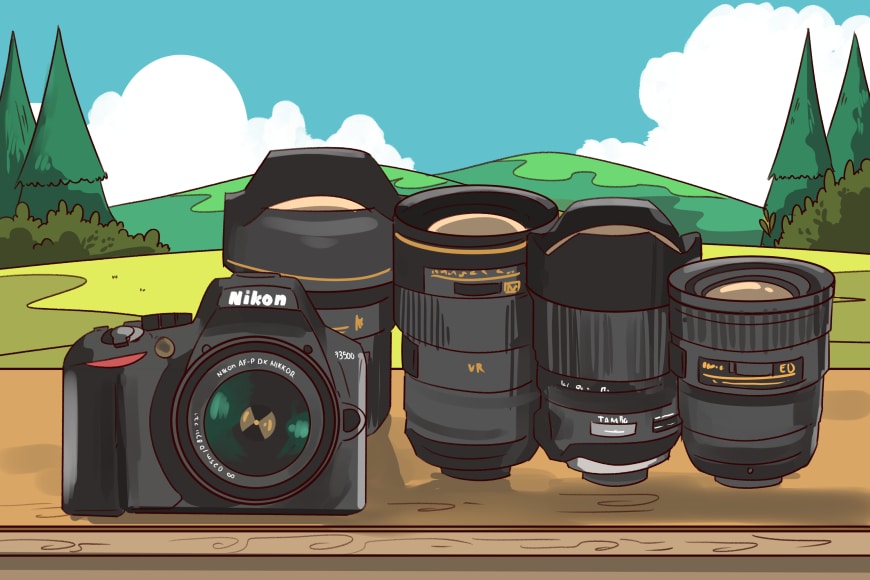If you’re looking for the best wide angle lenses for Nikon cameras, you’re in luck – there are lots of great options available here in 2024!
Whether you’re after an ultra wide angle lens, a zoom with multiple focal lengths, a lens with image stabilization, or simply the best optical performance, we’ve got a recommendation here for you.
While I’m a fan of wide angle prime lens options, (especially for DX sensor Nikon cameras which can benefit especially from larger apertures), it’s zoom lenses that we’ll be concentrating on here.
The image quality of the top primes vs zooms is almost identical these days, and zoom lenses with their variable focal lengths just offer so much more flexibility.
I’ll be recommending both Nikon and third-party wide-angle lenses in this guide, to ensure you get the best bang for your buck for your Nikon DSLRs or mirrorless cameras.
Let’s dive right in!
1. Nikon AF-S DX 10-24mm f/3.5-4.5G
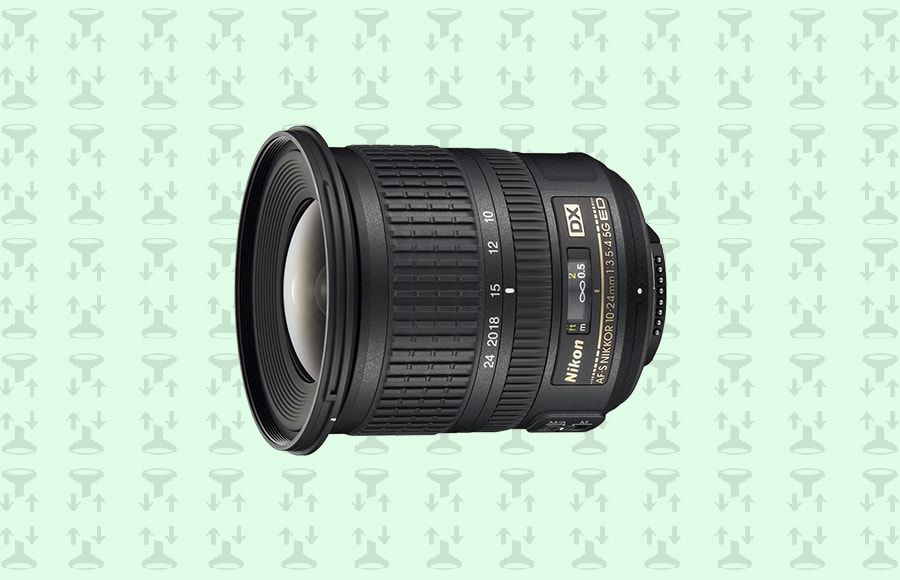
We suggest investing in this ultra wide angle zoom lens because Nikon lenses are optimized for use on Nikon camera bodies. It’s not designed for use with FX cameras.
At a 10mm focal length, this lens provides an impressive 109° angle of view. A focal length of 10mm offers a surprisingly distinct perspective compared to a focal length of 12mm.
It’s easy to see the difference, despite the focal lengths being only 2mm apart.
The build quality is great for a lens of this price. It’s made of durable plastics and is very lightweight.
Build quality is especially important for anyone needing tougher gear for frequent travel or outdoor use.
This lens for Nikon uses internal focusing, meaning that the barrel length does not change and the lens does not rotate when focusing.
The Silent Wave Motor, also known as the SWM, ensures quiet and fast autofocus.
The Nikon AF-S DX 10-24mm f/3.5-4.5G pairs excellently with a 24-70mm and a 70-200mm lens kit.
A maximum aperture of f/3.5 is a welcome quality in this lens because you can shoot in low-light conditions more easily and capture images with softer, bokeh-filled backgrounds.
Like the first lens on this list, the option to open your aperture a half-stop wider can make a huge difference for photographers who frequently shoot in darker scenarios.
The Nikon 10-24mm DX also provides incredible resolution. The distortion is dramatically reduced when you apply in-camera correction to JPEG files, so be sure to do that!
Distortion is common with wide angle lenses like this one, especially at the 10mm focal length, so be aware that correcting this in-camera may crop out the outer edges of your frame.
You can also correct a certain amount of distortion with photo editing software.
More often than not, the perspective distortion is more apparent than the straight-line distortion. Keep your lens perpendicular to avoid perspective distortion; it’s easy for this to distract from the composition of your frame, but also easy to fix since you can see it through the viewfinder and adjust it as you shoot.
This lens has a seven-bladed round diaphragm, which will give you beautifully soft backgrounds and bokeh. Your background will be smoothest at the 24mm focal length rather than the 10mm focal length, but whichever you choose will give you a nice, creamy bokeh.
Preventing ghosting and flare is difficult, but the Nikon Super Integrated Coating drastically reduces it.
A wider angle of view makes it more likely that your image will capture the light source in the frame, so Nikon’s efforts to reduce flare and ghosting won’t go unnoticed with this lens.
There may be red and green fringing in RAW files, but you can easily use lens-profile correction in Lightroom and Photoshop to fix it, so it’s not something to be concerned about.
Overall, this lens produces beautiful image quality. It’s lightweight and has a lot to offer for its affordable price.
2. Sigma 10-20mm f/3.5 EX DC HSM for Nikon
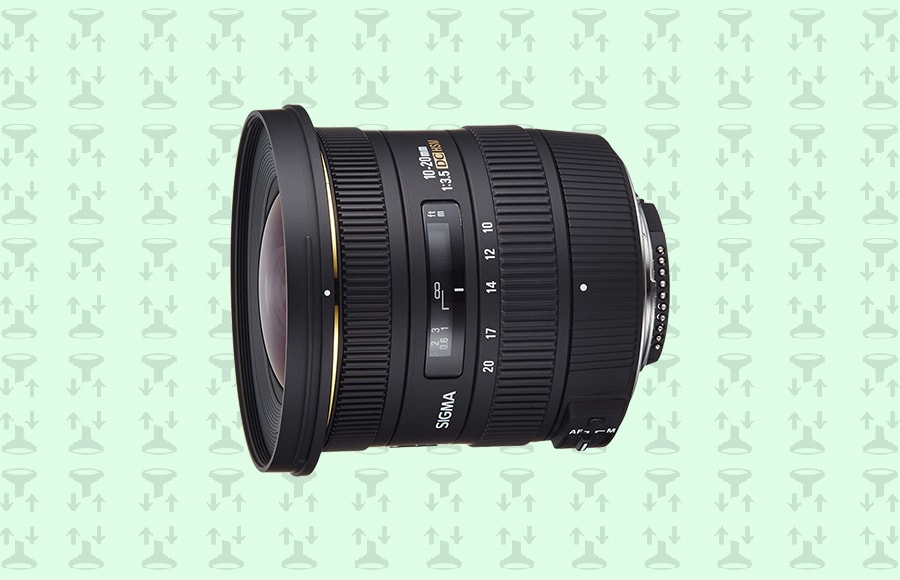
This ultra wide angle zoom lens may be a few years old, but it gives excellent value for money.
Value for money is always an important factor to consider, especially when you’re looking into a slightly older model like this one.
That said, there is a reason why this lens made it onto this year’s list of best wide-angle lenses for Nikon, and we’re happy to explain why.
Sigma is a reputable brand that’s known for its high-quality glass. There are many options to choose from in a range of prices.
With a maximum aperture of f/3.5, this lens is faster than others. A maximum aperture of f/4 is pretty standard for reasonably priced lenses, and for some, that might be enough.
But sometimes, that extra half-stop of aperture can make a huge difference in your photography, especially if you often find yourself shooting in low-light situations. Having a lens with the ability to let in more light is always an advantage because you gain flexibility in terms of what you can shoot and when.
This lens offers great low-light performance for an extremely affordable price. If shooting in darker scenarios is important to you and you want a more reasonably priced lens, we strongly recommend looking into this Sigma option.
The f/3.5 maximum aperture remains constant throughout the zoom range as well, which is always a good sign of the lens quality.
The Sigma 10-20mm f/3.5 EX DC HSM for Nikon has multi-layer coatings to reduce flare and ghosting as much as possible. This is especially apparent and helpful when you’re shooting a backlit subject.
The Hyper Sonic Motor (HSM) in this Sigma lens works to give you silent, high-speed autofocus. This is to be expected from higher quality lenses and it’s certainly an important feature to have when shooting in specific circumstances, like in crowds of people when you don’t want to draw too much attention to yourself.
The internal optics of this ultra-wide angle Sigma lens help prevent barrel distortion. Barrel distortion is very strongly associated with fisheye lenses because it’s a defining characteristic of that type of lens.
It’s great that Sigma has worked to reduce this as much as possible – since this lens is a wide-angle and not a fisheye lens, it’s important that distortion is minimal.
You can fix straight lines in most photo editing software, but only to a certain extent before image quality starts to become affected.
The internal optics also help reduce color fringing for images that are as sharp as possible.
This lens is quite large and heavy compared to others. It has a big front element and an 82mm filter thread, but if size and weight isn’t a concern for you then you will appreciate the quality of images that this lens offers.
A unique quality of this lens that makes it stand out from other wide angle lenses is its filter attachment thread. This will let you easily use 82mm thread filters on the lens.
This lens comes with a lens hood, which is important if you’re trying to prevent lens flare. For anyone working outdoors or in situations where lens flare is a possibility, a lens hood is an absolute must.
It also comes with a soft lens case for protection, which is always appreciated when purchasing a new lens, and especially so for those who travel often.
The only downfall of this Sigma zoom lens is its lack of weather sealing. Aside from that, it’s still a wonderful lens to have in your camera bag.
We recommend using this Sigma wide angle lens for Nikon DSLRs because it’s easy to handle and offers excellent value for money.
3. Sigma 8-16mm f/4.5-5.6 DC HSM for Nikon
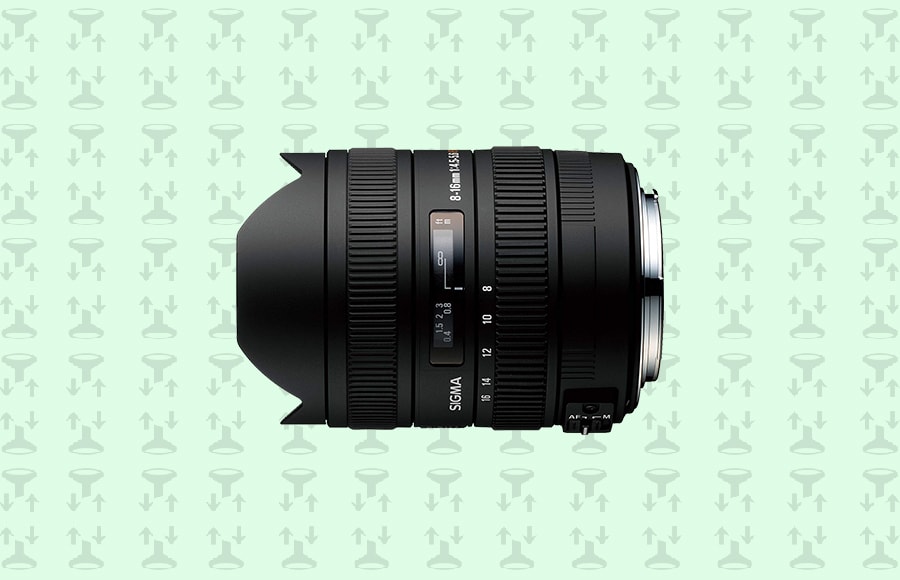
We recommend this ultra wide angle zoom lens as one of the best for Nikon because it’s an affordable option that provides amazing quality images. It’s another one from Sigma because they really do produce high-quality glass.
This lens is surprisingly sharp in every corner of the frame when you use a wide open aperture. That alone is reason enough to consider this lens.
Image sharpness is very important, of course, and some lenses tend to become softer in the corners, so it’s great to have a lens that remains clear in every part of the frame.
This lens is optimized for use on a crop-sensor camera, so for those of you using APS-C sensor bodies, this is a strong contender if you’re looking into investing in an ultra wide angle zoom lens.
Landscape photographers using a crop-sensor camera body will be able to appreciate the deep depth of field offered by using a narrow aperture and the full range of focal lengths that this particular Sigma wide angle zoom lens provides.
This is a great lens for capturing large groups of people and group shots, but we don’t recommend it for closer perspectives as lenses with a very wide angle of view will distort the objects closer to the lens to make them appear larger. The end result would not be so flattering for your model!
This Sigma lens also works really well for shooting in small spaces, making it an excellent candidate for real estate and interior photographers.
There’s significantly more barrel-distortion at the 8mm end of the zoom range but it gets better towards the 16mm end. You can always use the distortion to your advantage for more interesting shots, however, so this creates an opportunity to flex your creative muscles.
This Sigma lens does an excellent job of controlling chromatic aberrations, especially for a zoom lens.
One of the reasons why we suggest using this lens for Nikon bodies is because the zoom ring rotates in the same direction as Nikon lenses.
If you’ve ever switched between Canon and Nikon lenses, you’ll know just how difficult it can be to remember which direction you should be rotating your zoom rings.
This may seem like a small detail, but it’s a great feature for Nikons users as they’ll be able to shoot and adjust their lenses as quickly and easily as they normally would with other Nikon lenses. For landscape and architecture photographers who shoot in rapidly diminishing light (like golden hour and twilight), timing is everything, so the identical zoom ring rotation direction can save precious time.
This lens has a fixed lens hood to help prevent lens flare.
This is a fantastic option for low-budgets and APS-C bodies, and for those of you looking for good quality, consistently sharp images.
4. Tokina AT-X Pro 12-28mm f/4 DX for Nikon
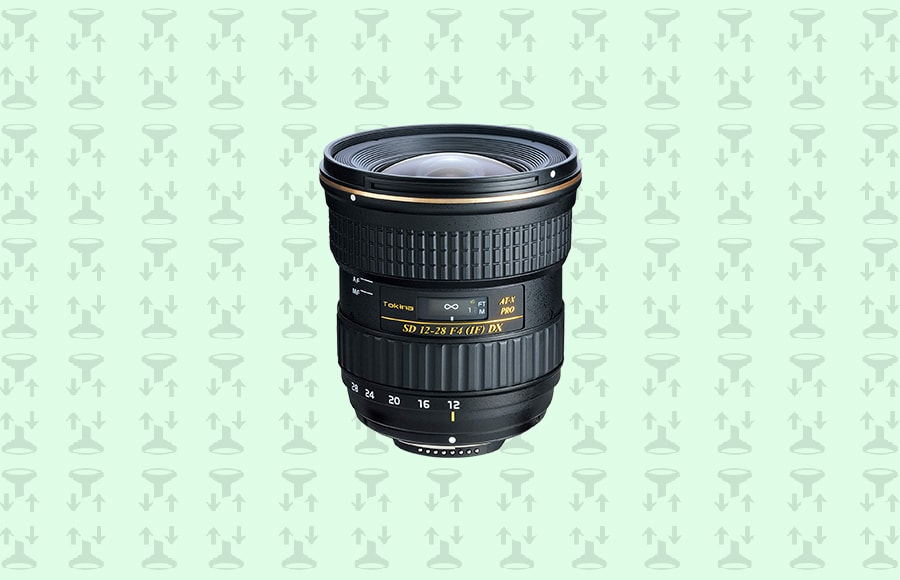
The Tokina AT-X Pro 12-28mm f/4 DX is one of the best lenses to use with a Nikon body because of its build quality and overall image quality. It’s designed for crop sensor Nikon DX cameras.
This is another example of a very affordable lens that functions best on crop-sensor bodies. It’s hard to beat this kind of value for money.
This lens retains an incredible image sharpness throughout its zoom range, which is an especially important quality considering how reasonable the price is. The sharpness is incredible at maximum aperture and increases as the lens is stopped down.
This lens offers a 2.3x zoom for both crop-sensor Nikon and Canon bodies.
Zoom adjustments don’t change the 77mm filter ring or the length of this lens, thanks to the internal focusing. This means that you do have the ability to use filters, like polarised filters, on your lens.
This is something that not many ultra wide angle lenses offer, so it’s a key component of why we added this lens to the list of best wide angle lenses to use with Nikon. Filters are especially helpful for landscapes photographers.
Internal focusing is near silent for this lens, thanks to the SD-M (Silent Drive-Module) autofocus motor.
It’s very user-friendly and easy to disengage autofocus for this lens, a welcome addition by Tokina since manual focus adjustments can’t be applied whenever you want. All you need to do is slide the focus ring forwards or backwards to disengage the autofocus and adjust it manually.
Tokina is a reputable brand, so seeing small compensations like that make a big difference if you’re considering buying one of their products.
This lens offers impressive chromatic aberration control, even after massive enlargements and harsh cropping. For a budget lens like this, that’s an excellent quality to have that sets this lens apart from others.
Although there is minimal distortion, there is still a small percentage of it visible. Luckily, the distortion pattern is even across the frame so it’s very easy to eliminate in post-production by using image editing software.
Another great aspect of this lens is the inclusion of a lens hood with its purchase.
As we know, lens hoods are fantastic for reducing lens flare in most cases. This is very important for ultra wide angle lenses like the Tokina AT-X Pro 12-28mm f/4 DX.
This lens is similar to its Nikon counterpart in terms of its image quality and overall optical performance, but is quite a bit cheaper.
5. Tokina AT-X Pro 11-16mm f/2.8 DX II for Nikon
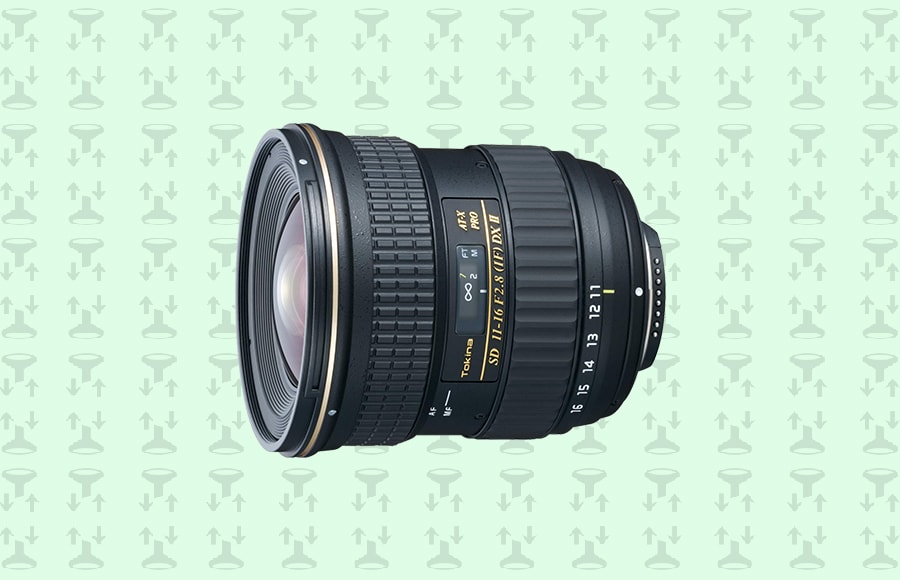
This is another amazing Tokina lens. The Tokina AT-X Pro 11-16mm f/2.8 DX II for Nikon is faster glass than the other ultra wide angle lenses on this list, and just as good in terms of image quality and performance.
It’s an extremely affordable lens considering its maximum aperture of f2.8.
As a DX lens, it’s ideal for use on a crop-sensor Nikon body. Its full-frame focal length equivalent for a 35mm sensor would be 16.5mm to 24mm.
It’s optimized for landscape, architecture, and interior photography like most lenses with an angle of view as impressively wide as this.
It has an impressive maximum aperture of f2.8 to let in as much light as possible. With a fast lens in your kit, you have the versatility to shoot in a multitude of environments and conditions.
You can use the open aperture for beautiful bokeh effects in your background. You also have the ability to shoot high quality images in dimly lit situations.
As a versatile Tokina lens with an aperture range of f2.8 to f22, you can expect consistant, unwavering brightness throughout its entire zoom range. This kind of reliability is part of what makes this lens such a great one to use on your Nikon camera body.
The aspherical and low dispersion elements help to control spherical aberrations and distortions and elevate the overall image quality.
The One-Touch Focus Clutch mechanism for this fast glass allows for quick changes between autofocus and manual focus. For photographers where time is incredibly important, this is an immeasurably helpful feature.
It’s great to have the option to switch between autofocus and manual focus. Not all crop-sensor lenses in this price range offer that choice, so it’s a great quality to have and yet another reason why this lens is one of the best wide angle lens for Nikon.
This Tokina lens has a 77mm filter thread and a multi-layer coating to suppress ghosting and flare. As we’ve seen with other lenses, this is an important feature in wide angle lenses to maintain image quality and contrast.
This is the fastest glass on the list. We recommend this lens for Nikon because of its advanced design, f2.8 maximum aperture, its autofocus motor, and generally outstanding performance – all for an affordable price.
Frequently Asked Questions
Is the Nikon 18 55mm a wide-angle lens?
This is considered a moderate wide angle, meaning its 18mm focal length has a wide angle of view and its 55mm focal length is more akin to a short telephoto.
What is a wide-angle lens used for?
It can be used for everything from landscape photography to architecture, real estate and interiors, and large wedding parties. This lens is quite versatile but we don’t recommend it for closeup portraits.
Wide angle lenses create distortion for any object closer to the camera – like someone’s nose, for example – making it appear much larger than it actually is, which is not the most flattering perspective for people.
Is 18mm a wide-angle lens?
A lens with an 18mm focal length is considered a moderate wide angle lens.
Final Words
There are many great wide angle lenses for Nikon out there, from third parties and from Nikon. We rounded up some of the best choices for this year.
You have a lot of options to choose from, as seen on this list, in terms of your budget, camera body (crop sensor or full frame), and photography niche. Each lens is a great one to have in your kit, whether you’re choosing it because of its low-light performance of rugged weather-proofing capabilities.
Whatever you decide, we hope that this list helped you to decide (or at least narrow down your choices) which lens is best for you.

